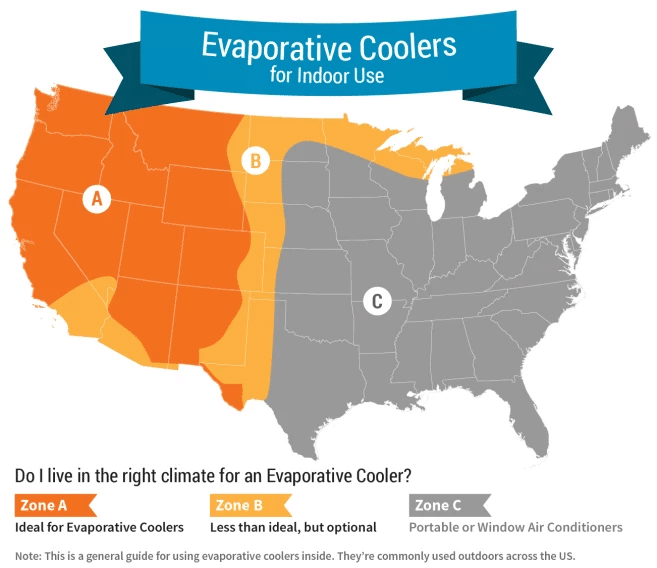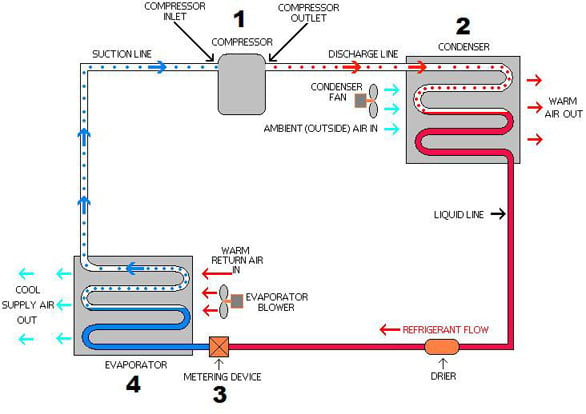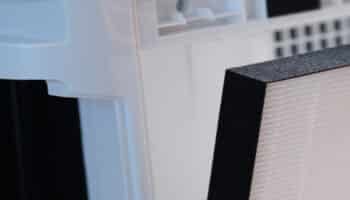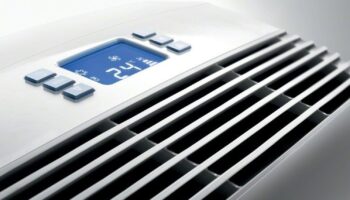It’s a sweltering summer’s day.
Just like every year, here we are again.
With your favorite summer shorts on and an iced drink in your hand, you reach over to turn on your brand-new… what?
Air Conditioner? Swamp Cooler? What would complete this picture better? Which would leave your family feeling cooler and more comfortable?
Well, that’s what we’re here to solve. I was stuck on this very question, and dove into researching it fully. Below you’ll find every point of comparison between these two great cooling tools. As well as recommendations for what’s best in different situations.
In short, you want a swamp cooler for a dry climate or an air conditioner for a wet one. Swamp coolers are quieter, cheaper, and easier to use – but they’re not as advanced. An air conditioner will cost you more, but in return, you get great cooling, dehumidifying, and accurate temperature control.
However, there’s much more to it than that. Read on to find out more.
Air Conditioners vs Swamp Coolers Compared
Before we dive into the really detailed parts, I want to share this pros and cons table with you.
Sometimes the easiest way to compare two products is to write out everything in one simple table and look at it all at once.
| Pros | Cons |
|---|---|
| Swamp Coolers | |
| Cools air in dry climates | Bad for humid air environments |
| Adds moisture to air | Not as effective as cooling |
| Energy efficient | Needs water top-ups |
| Better for the environment | Needs more maintenance |
| Easy to set up and install | Can be bad for asthma/respiratory conditions |
| Quiet | |
| Cheap to run | |
| Air Conditioners | |
| Can dehumidify air | Bad in super dry areas. Needs humidifier. |
| Easy to install | Needs a window for exhaust hose |
| Accurate temperate controls | Costs more (to buy, run, maintain) |
| Minimal maintenance | Needs a window for exhaust hose |
| Much better cooling power. | Noisier |
Still not sure what’s better for you? Don’t worry. Read on and I’ll go through each point in much more detail.
Try to bear in mind what aspects will be most important to you and your home.
Humidity
One of the main differences between swamp coolers and air conditioners is in humidity.
Swamp coolers blow air through a wet material. This adds a ton of moisture to the air.
On the other hand, air conditioners dry air before releasing it back out. This removes moisture from the air.
This is always worth bearing in mind if you’re trying to decide between the two. If you live in a humid part of the country, an air conditioner is probably your best bet. Live in a dry area, though? Well, a swamp cooler will help keep that air feeling much more comfortable.
What if I live in a dry area but want an air conditioner?
That’s a good question. Making the air too dry might start causing issues with your eyes or skin. But it’s quickly solvable. You can add water separately using a humidifier, and some air conditioners can have their dehumidifying function turned off.
Ease of Installation
It’s tricky to provide one quick summary of setting these up as each appliance comes in many forms. For simplicity, I’ll focus on the most common – portable units.
In this case, neither portable version needs a professional to set things up for you. Both can have a slight few complications, though.
Portable air conditioners need a properly set exhaust vent, which needs to be secured into a window. This can be fiddly. You’ll need a screwdriver set, a spirit level, and maybe a second pair of hands.
Swamp coolers are simpler. They only need you to supply them with water. Usually through the scientific method of ‘fillin’ up yer biggest ol’ pot ‘n’ pourin’ er into that there swamp cooler tank!’
Price to Buy
The biggest price difference is the type of appliance you buy. As again, I’ll compare the most popular models – portable air conditioners/swamp coolers.
Swamp Coolers are always much cheaper than air conditioners. They can cost anywhere from $30 up to $300 for a quality portable one. (Though industrial models can go into the thousands).
In comparison, portable air conditioners start at around $300 and quickly go above $5-600 for a standard home model.
This makes sense of course. A swamp cooler is essentially a fancy fan with some waterworks. An air conditioner is a carefully designed machine that accurately cools air using a chemical process.
Cost to Run / Energy Efficiency
Usually, a product that costs more to buy can cost less to run. Thanks to better energy efficiency, lower maintenance costs, and so on.
Not this time.
Air conditioners cost a ton more than swamp coolers to run. Always have and likely always will.
(Again, because an AC is a complicated machine that uses a lot of power. Powering a swamp cooler is basically like powering a big fan – the water is separate).
It’s in their other advantages that air conditioners win out. Better cooling, better control, and being able to dehumidify air.
The difference in energy efficiency is clear. Swamp coolers are incredibly energy-efficient coolers since they are only powering a fan. On the other hand, air conditioners can really blast up your cooling bill. If you’re shopping for one, make sure you get a model that’s at least Energy Star certified.
Effort to Maintain
With more mechanisms and moving parts, air conditioners can eventually need some expensive maintenance. The good news is that this is rare in modern models. Expect most AC units to last anywhere between 5–10 years with good care.
Want to make yours last longer? Check out our guides on portable and window air conditioner lifespans.
On the other hand, swamp coolers need daily maintenance. Thankfully, all that’s really required is refilling their water. (On a hot day, this may need to be done every couple of hours). Beyond that, only the pad needs to be replaced around once a month.
And if you get super unlucky, the fan may eventually break down. But that would be really rare.
Air Quality
Have you ever been in a room with moldy air?
You know, that old, funky, rotten plan kind of smell? The one you can almost taste?
Well, that can happen with a swamp cooler. If it’s left too long or not maintained properly, it’s not hard for mold to grow on the pad. This is why we need to replace the pads – especially after bringing them out of storage.
You also have no control over the air itself. If your window’s open, you’re just blowing around the outside air all the time.
Air conditioners let you control your air. By keeping your room sealed, the only new air is brought in through the air conditioner. And any good model will have a filter system to make sure you’re not breathing in pollutants, allergens, or other toxins.
This might not be a problem if you live on some lovely green land. But if you’re in a city or near a freeway, you might want to consider the clean air of a good air conditioner.
Noise
The only noise from a swamp cooler is the sound of a fan blowing. In good models, this can be close to whisper-quiet. Even the loudest versions can still be covered with a decent pair of headphones or speakers.
Air conditioners can make a bit of a racket. Mostly due to the compressor. CLUNK. Hummmmm… it gets old fast.
While older air conditioners were like nails on a chalkboard, these modern models can get close to whisper quiet. Most quality versions even have a super quiet ‘sleep mode’.
Features
Being a modern, digitally controlled appliance – air conditioners offer a ton more features than swamp coolers.
Remote controls, thermostats, timers, different modes… there’s a ton of control you can have over your own comfort. Some models can even provide you with heat – making them a truly year-round HVAC solution.
Swamp coolers are a bit more caveman, though. Most are simply a fan hooked up to a water system. If you’re lucky it may have a timer or even a remote control, but you’ll never have the advanced features of a modern air conditioner.
Climate
The area of the country you’re in can often dictate the humidity of your air.
So much so, in fact, that Sylvane came up with this great graphic showing what may be better for your climate.

Do bear in mind that this isn’t the be-all-end-all. If you simply want an air conditioner or a swamp cooler, there’s no reason not to get one!
So Which is Best?
With everything in mind – there are some simple takeaways we can use for recommendations.
Basically…
Get a swamp cooler if –
- You live in a dry climate
- You don’t need too much cooling
- You prioritize quietness
- You want to keep the budget down
- You don’t mind refilling regularly
On the other hand, Get an air conditioner if…
- You live in a wetter climate
- It’s hot!
- You prioritize comfort over budget
- You want less work after the installation
- You need accurate temperature control
- You have allergies/respiratory issues.
How Does Each Appliance Work?
Now that you know the main differences between either appliance, let’s take a quick look at how each one works. If you read this comparison, you were likely already familiar with the processes. But if you’re not, please read on to get some valuable information. Otherwise, feel free to move on to the next section.
Swamp Coolers
Let’s start with the easy one.
A ‘swamp cooler’ is basically a fan. A fan that blows air over a wet material.
Have you ever licked your finger, and held it up to feel the wind? You know how it feels a little colder when you do that? This is how a swamp cooler works. (Except with water, not saliva.)
Also known as evaporative coolers, these are simple appliances which is why they come so cheap. We take a powerful fan and direct its airflow over a wet material. This is typically a spongy, almost cardboard-like material. The ‘cooler’ trickles water down over the material to keep it damp. As the air passes through, it’s pushed through at a high speed by a fan and cools down in reaction to passing through moisture.
Not to mention that it takes on some of the water with it. Which is why swamp coolers will make your air more humid… like in a swamp!
Where does the water come from? Either by a plugged-in source for serious units, or poured in by you for more casual models. If it’s you doing the refilling, you also have the option of adding ice-cold water for better cooling.
Air Conditioners
There’s many types of air conditioners. Mainly central, portable, window, or mini-split models. But they all work the same way.
Air conditioners work using what’s called a refrigerant. This is a chemical liquid/gas that’s great at holding a temperature. It’s cooled down in the condenser, and then a fan is blown over it in the evaporator. The breeze produced is cold air, but the refrigerants warms back up again. So it’s taken back to the Condenser.

Conclusion
Swamp coolers and air conditioners both have their place in a home.
There are a lot of different things to consider, and each of them is important. If you’re still stuck, try to rank the above aspects in order of importance to you. Maybe you don’t mind the cost, but just can’t suffer any noise. Or you have dry air, yet need the control of an air conditioner. (So get one and a humidifier).
Regardless, I hope this guide’s helped shed some light on the difference between these appliances for you.
We’re entirely reader-supported, so please consider checking out some of our related articles below.
Thank you for reading, and have a great day!
—Craig.
Frequently Asked Questions
How Often Should I Refill My Swamp Cooler’s Reservoir?
Depending on how often you use your appliance, how big the reservoir is, and how well it’s been filled, you can expect it to last anywhere between 4–8 hours of continuous use.
Can I Fill My Swamp Cooler With Tap Water?
Technically yes, but there are some things to take into account.
While your appliance should run ok with tap water, sometimes there’s an excess of minerals present in it that can eventually cause limescale to build. This can obstruct your swamp cooler’s internal pathways, causing a world of trouble.
If the water in your area is known to contain minerals, it’s best to use distilled water.
Can I Use Any Swamp Cooler/AC to Cool Any Room?
Not really.
How well your appliances can cool a room, depends greatly on buying the right-sized units for the square inches you need to cool. Choosing an under or oversized swamp cooler/Air Conditioner can cause either too much or too little cooling in a determined area.
Moreover, using an oversized swamp cooler for a smaller room can lead to excess moisture, which not only raises the temperature but can also cause mold.







